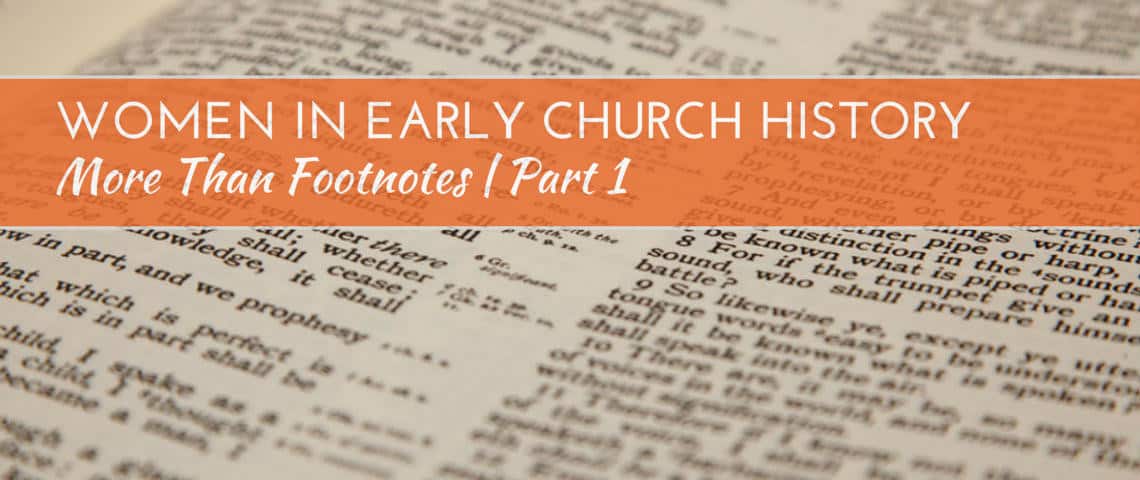
Part 1 in a series examining the role of women in different phases of Church history. See also Part 2 – Women in Medieval Christianity, Part 3 – Women in the Reformation Era, and Part 4 -Women in the American Colonies.
Many Christians have inherited the supposition that the Church has been built on the backs of men. Masculine, courageous, and often oddly wigged men. When we read philosophy and theology addressing the roles of pastor, apostle, disciple, missionary, etc., we subtly assume a masculine context unless women are specifically brought up.
Yet, failing to recognize the essential role of women in church history is to wrongly conclude that we should interpret our own story through the broken lens of “he shall rule over her” (Gen. 3:16) in place of humanity’s original commission for partnership (Gen. 2:18). Like the post-fall curses of death and toil, the curse of unequal partnership is certainly worth fighting as Christianity seeks to understand the leadership behind our historical identity.
In this series, the role of women in different phases of church history will be examined in order to offer a truer picture of Christianity which will benefit women and men alike.
In each installment I briefly highlight the gender-relevant context of a section of Church history before overviewing important female figures, primarily citing two works, Her Story(HS) and Discovering Biblical Equality (DBE) for reference. My hope is to offer readers a more complete picture of Christian history by focusing on the women who are too often footnoted and forgotten.
What role did women play in the earliest days of the church?
I am going to skip over most of the New Testament itself in order to avoid falling into a never-ending pit of Greek semantics, theological persuasions, or the painfully patriarchal world of Greeks, Romans, and Jews as recorded both in and outside of the NT. (Did you know that both Jews and Romans had daily rituals of thanksgiving for not being born female?) If you want more detail about women in Jesus’ ministry or Paul’s ministry, then click these links. For now, it is important to keep in mind that this is a survey of historical figures who are essential to the establishment of the Christian Church.
As leaders and evangelists in house churches, women played an essential role in the early Christianity.
House churches, the primary channels for the sustainability of the early Church, were funded and led by women such as Lydia (Acts 16:11-40), Nympha (Col. 4:15) and Mary, the mother of John Mark (Acts 12:12). In 1 Thess. 5:12 Paul suggests that such house-church leaders had significant authority as he tells his readers to be thankful for those who “have charge of you in the Lord.” In both Jewish and Greco-Roman culture, women did not always have equal access or rights in the public sphere, thus the home was the most socially acceptable and encouraged place for women to speak, teach, and take responsibility. It is within this household context that the Church was raised into infancy.
As the Church acquired legal status in Roman society, it became increasingly subject to the patriarchal ideology of the dominant culture.
No longer raising the Church in their homes, women were increasingly marginalized – even banned from church grounds if they happened to be menstruating (HS. 16). As the Church adopted more hierarchal structures in the 4th century, the positions at the top became only open to men as female bishops or presbyters would have been antithetical to Roman gender ideology (HS. 27).
No longer commonly recognized as partners (Romans 16; Phil 4:2) apostles, (Romans 16:7) and prophets (Acts 21:9; Rev. 2:20), women were often forced to look for other roles to fulfill. As Barbara MachHaffie notes, “historians generally agree that women had a decisive part in the creation of the church and played a more prominent role in the first generation of Christianity than they did in later centuries” (HS. 4).
With this rollercoaster of a trajectory in mind, here are some important post-New Testament leaders we all should know.
Perpetua and Felicitas
Perpetua and her servant Felicitas may be the best documented female figures to be martyred for their faith by Rome. After being held in prison in approx. C.E. 202 Perpetua and Felicitas were executed under Septimus Severus for their commitment to Christ (DBE. 24). Tossed into the gladiator arena, the women were gored and beheaded publicly. As a 22-year-old mother, Perpetua had the chance to deny her faith and return home with her father. Claiming her spiritual awakening, she and Felicitas chose otherwise (DBE. 24). The (possibly Montanist) record of Perpetua’s story reveals that she received prophetic dreams which helped her to emerge as the leader of the imprisoned community (some of which were male clergy) who were all executed by Rome (HS. 27). Perpetua’s leadership even led to regular Carthage holidays and special sermons from those such as Augustine the Bishop of Hippo (HS. 28).
Faltonia Betitia Proba
Proba was a wealthy Roman woman who converted to Christianity sometime in her adult life (HS. 28). Written in approx. C.E. 351, Proba’s Centro stands today as a fascinating piece of early theological contribution in early Church history. Centro is a form of masterful ancient poetry technique in which the author would rearrange exact lines from a well-known work, such as Homer’s Odyssey, in order to provide new and expanding meaning (HS. 29). Proba applied this poetic art form to biblical texts such as the Hebrew Pentateuch and the Last Supper, offering an artistically original and painstakingly studious work of scholarship. Despite initial resentment in Roman culture, her theologically interpretive work was soon considered a classic, allowing it to be used as a textbook for centuries (HS. 29). Barbara MachHaffie notes that Proba’s work allowed for the Bible to become better understood and accepted by Roman culture, thus easing the growing hostility between Christianity and Rome (HS. 29).
Egeria
Pilgrimage to the Holy Land by a woman named Egeria may be the first formal writing in prose by a woman in Western European Culture. Egeria’s manuscript describes her pilgrimage to the Holy Land sometime in the early fifth century. Egeria’s diary reveals her deep understanding of scripture and appreciation for forms of worship in the Jerusalem church. Barbara MachHaffie observes that Egeria’s diary becomes especially important to early Christianity as it offers invaluable information on early church practices, architecture, and the condition of biblical sites in the fifth century (HS. 30). Egeria’s zeal for God drives her to break off her engagement, overcome the threats of attempted rape and execution, and eventually to adopt a life of celibacy. As the roles of female leadership began disappearing in the early church, Egeria’s devotion to the virgin life allowed for her to be a model women for many Christians. MachHaffie even suggests that—for better or worse—Egeria’s diary may have even been part of the impetus behind medieval Christianity’s (over)emphasis on the idolization of virginity (HS. 31).
References:
MacHaffie, Barbara J. (2006). Her Story: Women in Christian Tradition (2nd Edition). Fortress Press
Pierce, Ronald W., Groothuis, R. M., Fee, G. D. (2005). Discovering Biblical Equality: Complementarity Without Hierarchy. IVP Academic.
More on women in the early church:
The First Century Church and the Ministry of Women by Margaret Mowczko – how women were involved in house churches.
Women’s History Month: The Early Church by Lexi Friesen – more influential women (Nino, Macrina the Younger, and Leoba)
This series originally appeared on Restoring Pangea, where Michael blogs along with Josiah Daniels and Nathan Smith.



17 responses to “More than Footnotes Part 1: Women in Early Church History”
From the standpoint of a called and ordained minister who denied the call for over 25 years, allowing the voices of opposition to women in ministry dictate my disobedience, thank you for your research and your voice. It astounds and hurts deeply that I walked in disobedience for so long and at the same time to continue to encounter the level of opposition that still exists, even in a denomination that ordains and sanctions the call of women. Confusion abounds – but thankfully, truth brings freedom. God bless you for lending your voice to a world desperately in need of freedom.
Hi Matthew,
Thanks so much for your post. I enjoyed reading (both parts of it), and share your passion for studying women in church history. I too am a student at Fuller, though I’m in the PhD program and not on campus much. I have written on my blog about women in church history a few times. I’d love to hear your thoughts on some of my posts:
https://dansalyers.wordpress.com/category/women-in-church-history/
Thanks and Best Wishes!
Dan Salyers
Hey Dan, thanks for your comment! I really appreciate your reading and encouragement. I just spent some time reading through your blog and found it very helpful and interesting! I’ve got you bookmarked now and plan on spending some more significant time in your blog once I make it through finals week. Hope to see you around Fuller in the mean time.
Peace,
-Michael
Thanks Michael! Best of luck on Finals this week!
Thanks for reading, Matthew! Best of luck on Finals this week!
Dan
I’ve been researching Egeria this year because of my involvement in an online project (www.lentmadness.org) about the saints. Her travels all around Palestine, Turkey, and Egypt were really remarkable for that time, as was her records of what local faith practices looked like in these places.
The failure to include these women alongside the church “Fathers” seems like a symptom of the truism that history is written by those who run the joint. Men were dominant in the society and their sarx prevented them from following Jesus’ example of putting women and men on an equal footing. We see it still happening in some parts of the church today. Thanks for giving solid examples of real women who did real work for the early church.